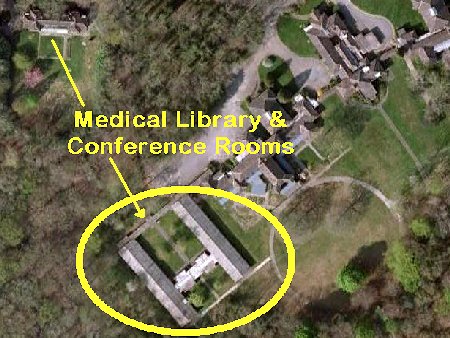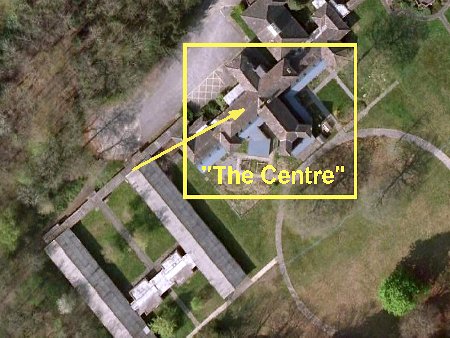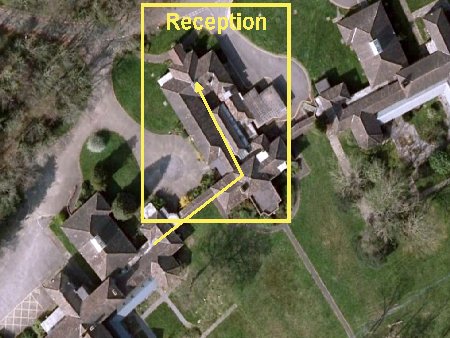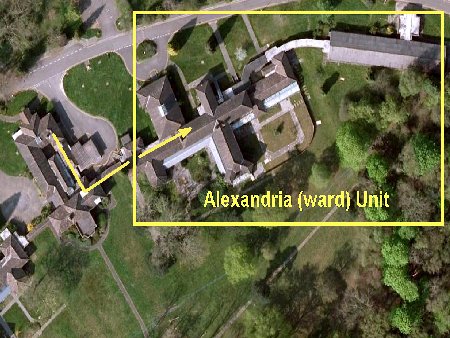|
The mental asylums of the Victorian and Edwardian periods tended to be constructed very much to a common design concept - that of a central ballroom, kitchens and associated services, treatment areas and administration, around which were then built numerous ward blocks, Whittingham near Preston is a prime example. Every area of the asylum was connected together with a series of corridors laid out like the spokes of a wheel, or in a linear fashion. The great advantage of such a design was that any part of the hospital could be reached without having to brave the elements outdoors. The down side though was that patients felt a tremendous sense of isolation in such imposing buildings with corridors that seemed to go on for miles. Barrow Gurney was constructed instead to a design where self contained ward block villas where isolated totally from each other, the "heart" of the hospital for administration and treatment being situated in a totally separate complex on another part of the site. To the north a large block with it's own kitchen, refectory and function hall, was built for the nurse's accommodation thus providing off duty staff a complete break from the presence of the patients.
During the 1930s the western world sank into a period of deep economic depression following the Wall Street crash and so funding for public works in Britain became very tight. As a result the hospital was built quickly with functional red brick, and yet despite the utilitarian construction it was still very pretty. The villas were surrounded by lawns and landscaped gardens and the extensive mature woodland already present on the site was managed in such a way as to isolate and screen the individual villas from each other, creating a sense of peace and privacy. Despite not being officially open at that point the first patients arrived in May 1938, but war clouds were looming on the horizon. Upon the outbreak of the Second World War the hospital was requisitioned to serve the Royal Navy who did not hand it back until 1946. Bristol Mental Hospital was straining at the seams so the return into service of Barrow Gurney greatly alleviated the problem. On the 5th. July, 1948 the hospital was transferred to the newly formed National Health Service and both Barrow and the Bristol Mental Hospital were jointly managed by the Bristol Hospital Management Committee under the South Western Regional Hospital Board. With it's distinctive and highly individual layout - there were only a few mental hospitals constructed in this fashion, Aston Hall near Derby being one that springs to mind - and possibly the best stocked medical library of it's time Barrow Gurney was regarded as a progressive and forward thinking institution and it even hosted clinical conferences for psychiatrists and doctors from all over the country. Attitudes to mental health issues were changing in Britain by the 1950s and the stigma attached for so long to patients incarcerated in "the nut house" had already begun to change when the old term "asylum" was dropped in the 30s. Now things went a step further and the term "mental" was dropped as well - it was now just plain old Barrow Gurney Hospital. By 1960 the hospital's population peaked at 453 patients but numbers began to fall as more provision was made for care at home following the instigation of Enoch Powell's far reaching policies. A target was set whereby there were to be no more than 200 patients in care at the hospital by 1975 and although it was not quite attained numbers did progressively decline until by the 1990s only three residential wards remained and the majority of patients were treated as out patients or with community support workers. The writing was on the wall and in 2003 it was announced that Barrow Gurney would close by 2008. In 2005 a national survey of NHS hospitals was carried out and Barrow Gurney earned the dubious distinction of being the dirtiest hospital in the country, with "an unacceptably dirty environment". This harsh criticism accelerated the closure of the hospital. Two of the remaining wards were shut down immediately, and by 2006 the last ward closed it's doors. And that is where the story of Barrow Gurney Hospital should end. But nature has a way of perverting the course of man! Developers Del Piero bought the site and immediately put comprehensive security measures in place, so for a time Barrow Gurney was practically impossible to explore. Their original plan was to drop most of the buildings on site and replace them with a modern housing estate and an extensive office complex. Planning permission was applied for and granted but a revision has recently been applied for which will see more housing and a massive reduction in the proposed office complex in favour of a "care village" for the elderly, with sheltered accommodation, a 38 bed care home, and a high dependency home for those needing 24 hour care. In addition there will be a small retail complex and a bar and restaurant. But shortly after the initial demolition began it was found that bats had taken roost in many of the buildings, and as bats are highly protected, demo had to stop. A number of "bat houses" were constructed with the aim of enticing the creatures out of the old buildings, but to date they have not particularly taken a fancy to their prospective new homes and an impasse has been reached! Bats 1 - Developers 0! Of course that's pretty good news for your average urbexer! The trouble now though is that Barrow Gurney has been visited by other groups of curious explorers as well, many of whom are rather less respectful of their environment. Metal theft and rampant chavvery means that the hospital buildings, with their extensive use of light weight construction techniques such as studded walls et all, have suffered very badly in a relatively short period of time. Just 15 years after closure Barrow Gurney is a complete and utter mess of total dereliction with little left intact to see. The mortuary is gone, as is the dentistry and the library; in fact it was impossible to identify any of these previously obvious structures. Access to the site was really easy - we parked in a lay by on the A370 and climbed up the banking to emerge rather muddier than we would have liked in the courtyard at the back of Woodside, the nurse's accommodation. We explored Woodside, the Mother and Baby Unit, "The Centre" (the admin and treatment section of the hospital) and the Alexandria Ward unit, however we did not bother with any of the isolated ward villas, being rather under whelmed by the degree of desolation we were encountering everywhere. The workshops, boiler houses and stores have been almost completely demolished however nothing has been cleared so this area if a vast pile of rubble. It appeared to us initially that the Medical Conference rooms and Library complex had been demolished but upon study of our photographs we "found" them again - that just shows how badly damaged everything is! Whilst wandering around in all this desolation how strange it was to find a couple of brand new builds - simple four square single story constructions, one with a way in, one without - bat houses. And it was at one of these where I got the fright of my life as a huge owl appeared from an opening high up on a wall and flew past me within a couple of feet of my head! They are completely silent which makes the shock that bit greater! So... lets get on to the pictures now. We've tried to make them flow in the general order in which we explored the hospital together with a couple of interactive panoramas...
|
 In
order to prevent over crowding at the existing Victorian mental asylums in
Somerset in the 1930s it was decided that a new mental hospital would have
to be constructed. Work began on Barrow Gurney Mental Hospital in 1934 to
the design of the Bristol architect Sir George Oatley. Final completion
was late in 1937 however it was not officially opened for more than a
year. Sir Lawrence Brock CBE, of the Hospital Board of Control, cut the
ribbon.
In
order to prevent over crowding at the existing Victorian mental asylums in
Somerset in the 1930s it was decided that a new mental hospital would have
to be constructed. Work began on Barrow Gurney Mental Hospital in 1934 to
the design of the Bristol architect Sir George Oatley. Final completion
was late in 1937 however it was not officially opened for more than a
year. Sir Lawrence Brock CBE, of the Hospital Board of Control, cut the
ribbon.  The
concept behind this "villa plan" layout was to give patients a sense of
privacy and community, this having been found to be profoundly beneficial
to their mental wellbeing.
The
concept behind this "villa plan" layout was to give patients a sense of
privacy and community, this having been found to be profoundly beneficial
to their mental wellbeing. 




